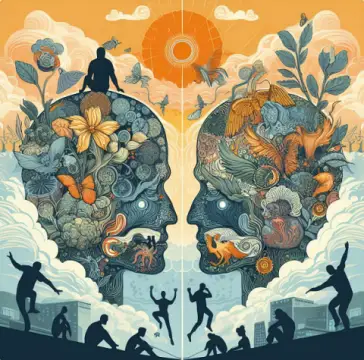Table of Contents
The Silent Killer
Hypertension, also known as high-blood pressure, is a disease that almost half of American adults suffer. That is an astonishing 48.1% or 119.9 million Americans. Serious health consequences occur when hypertension is left untreated and even more astonishing is the fact that only 1 in 4 adults have their hypertension under control. Though shocking, hypertension is largely controllable and perhaps avoidable in many cases by altering lifestyle and diet. If you already have hypertension, learning how it impacts the body holds tremendous importance, so you understand why you must eat healthy and exercise.
They don't call hypertension the silent killer for nothing.
What is Hypertension?
Hypertension is a chronic medical condition where blood pressure increases due to constriction of arteries. The normal rand of blood pressure is measured using two metrics: systolic and diastolic pressure. These measurements are dependent on the contraction of the heart muscle. When the heart muscle is contracting this measurement is known as systolic. When the measurement of blood pressure is taken between beats of the heart or when the heart is relaxed this is known as diastolic. The measurement is produced with the maximum (systolic) over the minimum (diastolic) pressure (American Heart Association, 2014). This measurement is compared with what is considered the average range for a person and this makes the determination of high blood pressure.
There are several categories of hypertension that are identified by their systolic and diastolic ranges.
| BLOOD PRESSURE CATEGORY | SYSTOLIC mm Hg (upper number) | and/or | DIASTOLIC mm Hg (lower number) |
|---|---|---|---|
| NORMAL | LESS THAN 120 | and | LESS THAN 80 |
| ELEVATED | 120 – 129 | and | LESS THAN 80 |
| HIGH BLOOD PRESSURE (HYPERTENSION) STAGE 1 | 130 – 139 | or | 80 – 89 |
| HIGH BLOOD PRESSURE (HYPERTENSION) STAGE 2 | 140 OR HIGHER | or | 90 OR HIGHER |
| HYPERTENSIVE CRISIS (consult your doctor immediately) | HIGHER THAN 180 | and/or | HIGHER THAN 120 |
In general, the normal range of blood pressure at rest is within the range of 100–140 mmHg systolic and 60–90 mmHg diastolic. High blood pressure is considered to be in the range of 140/90 mmHg and above. In this range, blood pressure needs to be controlled (American Heart Association, 2014).
There are two forms of hypertension known as primary hypertension and secondary hypertension. The majority of cases of hypertension, 90–95% are diagnosed as primary. Primary hypertension is defined as being high blood pressure that has no apparent medical cause. All secondary cases of hypertension are caused by diseases or conditions “relating to the kidneys, arteries, heart, or endocrine system.” (American Heart Association, 2014)
Causes of Hypertension
There are many factors that impact a person’s blood-pressure at any given time including: family history, lifestyle, diet, stress levels and ethnicity. All of these factors contribute to determine one’s blood-pressure. Family history of high blood-pressure is an important factor because this factor increases one’s chances statistically of developing hypertension.
Lifestyle is another factor which has been linked to the risk of hypertension. A sedentary lifestyle can greatly increase the risk for hypertension by as much as 50%. In research on hypertension, exercise was found to be an enormous factor in reducing the risk of the disease. It was found that people who perform aerobic exercise, such as walking or cycling for 30–45 minutes three times per week, could lower their blood pressure significantly, reducing systolic blood pressure by approximately 11 mm Hg.
As well, poor diets also increased hypertension risk. Sodium is large risk factor in hypertension. About 51% of people with hypertension are sensitive to salt. Low salt diets reduce blood pressure in individuals with hypertension. The reasons for low slat diets are steeped in controversy. While these diets appear to reduce hypertension the reason for this is not clear. It may be that salt interactions with potassium may create imbalances in the body and cause increased blood pressure. According to the American Heart Association it is important to maintain a diet with potassium for controlling blood pressure because potassium reduces the impact of sodium: 3,400 milligrams for men and 2,600 milligrams for women.
Stress and hypertension also seem to go hand in hand but not in a direct causal manner. There is no direct link between stress and hypertension but it is believed that stress causes other activities which increase the risk of hypertension. For example, eating poorly and using drugs and alcohol are often caused by stress. The use of substances in this manner can increase blood pressure, especially alcohol.
Another factor that seems to be related to hypertension is ethnicity. Some ethnic groups such as African Americans and Asians seem to have an increased prevalence. Professor Morris J Brown, there are numerous studies which seem to confirm this finding, “Black people clearly have a higher prevalence than … white people,” and another study, “reported twice as much hypertension in black and Asian people."
Researching and diagnosing hypertension can be extremely difficult because of the number of biochemical interactions which are taking place in hypertension patients. There are many changes in chemistry that there are different types of screening that measure different chemical levels. The most comprehensive screening is known as chem-20, SMA-20, or SMAC-20. This test examines 20 different chemicals in the blood. The comprehensiveness of this test is due to the fact that the asymptomatic nature of hypertension does not always present itself in sodium or potassium levels. This highlights the fact that knowledge concerning hypertension continues evolving, and the challenge for patients who may experience no symptoms.
Symptoms of Hypertension
There is little symptomatology exclusive to hypertension. The lack of symptomology makes hypertension a dangerous condition because it often goes unnoticed until too late. Headache is often associated with hypertension but is not always present. Elevated sodium levels is another symptom of hypertension. Stress is perhaps the most common symptom but along with the other symptoms this may or may not be present.
The only time that symptoms are clearly present is when a person enters a state known as hypertensive crisis. Hypertensive crisis occurs when blood pressure readings spike dangerously. In this state, the systolic reading will be 180 or higher. The diastolic reading will be 110 or higher. This state presents several obvious symptoms including severe headaches, anxiety, shortness of breath, and nosebleeds.
When a person is in a hypertensive state, they will need immediate emergency medical help in order to bring blood pressure down. This condition can be fatal if not treated immediately.
The Impact of Hypertension on the Body
Hypertension has a profound impact on the body. It is typically characterized by a persistent elevation in the force of blood pushing against the walls of the arteries. The effects of hypertension are far-reaching and can contribute to several health complications if left uncontrolled.
The impact on the body of persistent hypertension is significant. Hypertension essentially forces the heart and blood vessels to work harder than necessary, leading to their gradual weakening over time. This strain can result in damage to the circulatory system and increase the risk of heart disease and stroke, two of the leading causes of death globally.
One of the most concerning impacts of hypertension on the body is its effect on the heart. High blood pressure can cause a variety of heart-related issues including coronary artery disease, heart failure, and irregular heart rhythm (arrhythmias). In coronary artery disease, the arteries supplying blood to the heart become narrow or blocked due to the buildup of cholesterol, impairing normal blood flow. The heart has to pump harder to compensate, increasing the risk of heart failure where this vital organ cannot pump enough blood and oxygen to support other organs in your body.
Moreover, Hypertension also exerts a significant impact on the brain. Just like the heart, the brain relies on a nourishing blood supply to function properly and survive. High blood pressure can cause several complications, including transient ischemic attack (mini-stroke), stroke, dementia, and mild cognitive impairment. Furthermore, hypertension is a significant risk factor for kidney disease. Over time, high blood pressure can damage the delicate blood vessels within kidneys, impairing their ability to effectively filter toxins from your bloodstream.
Beyond these major organs, hypertension effects are seen in other parts of the body too. For instance, it can lead to hypertensive retinopathy, damage to the blood vessels in the retina that can cause blurred vision or loss of sight. Hypertension can also impact sexual function, particularly in men, by diminishing the flow of blood to the lower regions of the body.
The impact of hypertension on the body is multi-faceted and severe, affecting nearly every organ system. It underlines the importance of regular blood pressure checks and maintaining a healthy lifestyle to prevent hypertension and its associated complications. It is vital to ensure adequate management of hypertension through a combination of medication, dietary changes, exercise, and lifestyle modifications to mitigate these risks and protect overall health.







